Synchronize Contacts with Microsoft 365 (server)
Applies to
This feature is available in module Contacts & Companies (Standard). For older plans, you need the Enterprise licence.
Warning
To use synchronization of contacts with Microsoft 365, your eWay-CRM must run in our cloud. If you use eWay-CRM on-premises, this feature will not be available.
Synchronization of contacts with Outlook (local) is not the only possibility how to synchronize your contacts. You can also synchronize your contacts with Microsoft 365.
Tip for elimination of duplicates
From Microsoft 365, you can import contacts you already have in eWay-CRM. To prevent duplicates, turn on the duplicate check in the Administration Center > Features > Contacts & Companies. Turn on Check for duplicates (by any of the email addresses). More here.
If contacts between eWay-CRM and Microsoft 365 are not already synchronized (or were synchronized in past) and you have the same contact in eWay-CRM and Microsoft 365, these contacts cannot be joined. On the basis of the same email address, you will see these contacts in the Duplicates Contacts folder in Microsoft 365.
If contacts between eWay-CRM and Microsoft 365 are not already synchronized (or were synchronized in past) and you have the same contact in eWay-CRM and Microsoft 365, these contacts cannot be joined. On the basis of the same email address, you will see these contacts in the Duplicates Contacts folder in Microsoft 365.
Tutorial for
- eWay-CRM Desktop
- One-way Automatic Synchronization From eWay-CRM to Microsoft 365
- Two-way Automatic Synchronization Between eWay-CRM and Microsoft 365
- eWay-CRM Online
eWay-CRM Desktop
One-way Automatic Synchronization From eWay-CRM to Microsoft 365
- On the eWay-CRM ribbon, go to eWay-CRM Settings.
- In Contacts tab, check the box Automatic Synchronization With Microsoft 365 (server mode).
- Then click Configure.
- Turn on the Synchronize my Contacts with Microsoft 365 toggle and login to your Microsoft 365 account.
- Select the folder of Microsoft 365 contacts where you want to synchronize your contacts from eWay-CRM and click One-way from eWay-CRM to Microsoft 365. Contacts will be synchronized only from eWay-CRM to Microsoft 365, not the other way around.
- If you want to synchronize also categories of your contacts, check Synchronize categories. Then, click Save.
- The initial synchronization will start. After successful finish, you will see your eWay-CRM contacts in your Microsoft 365 account. Every change on eWay-CRM contact will be synchronized to Microsoft 365 too.

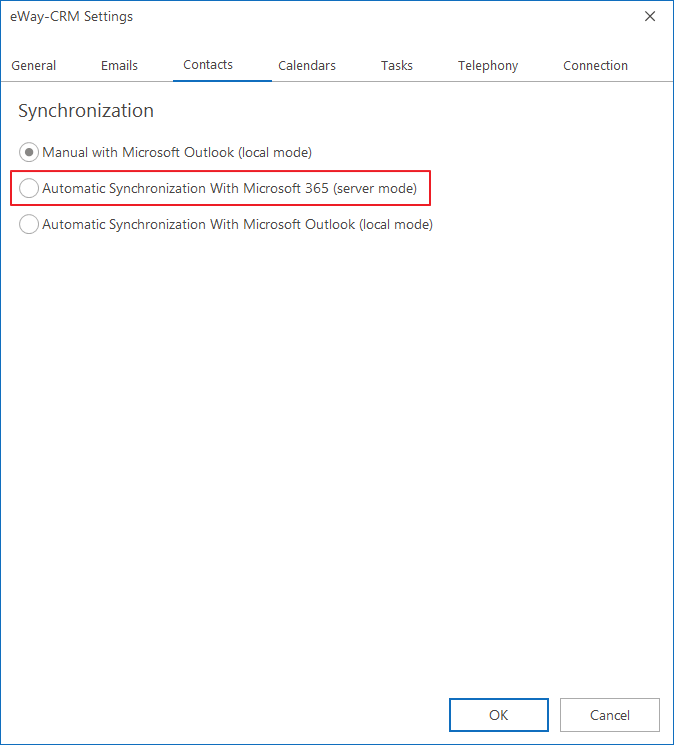
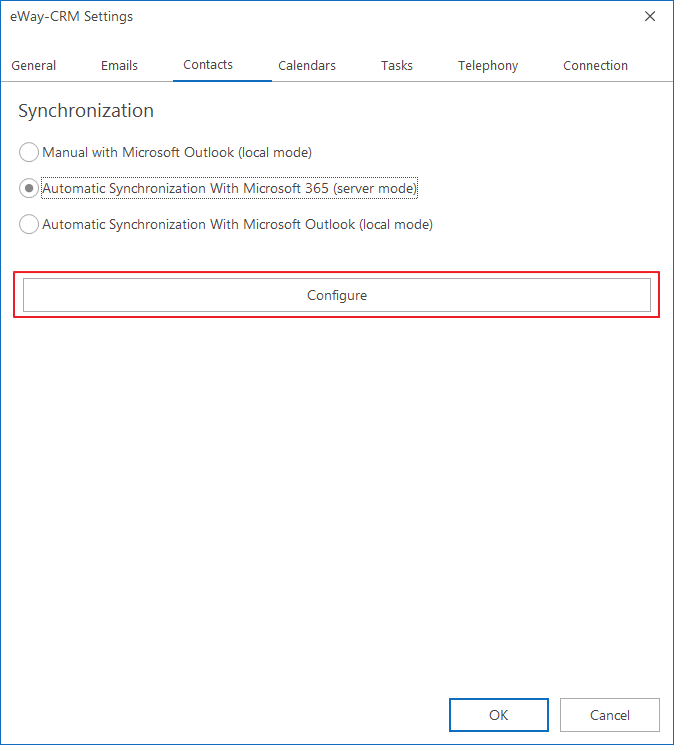
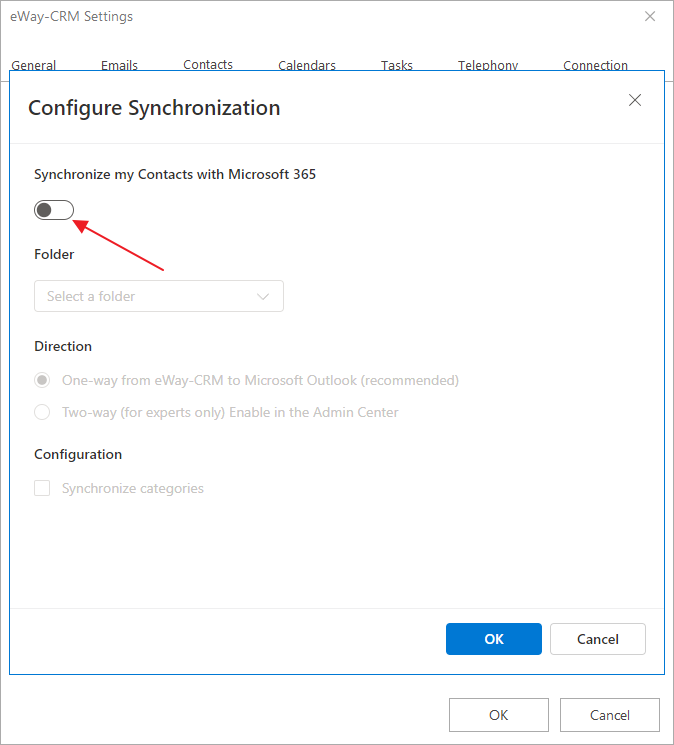
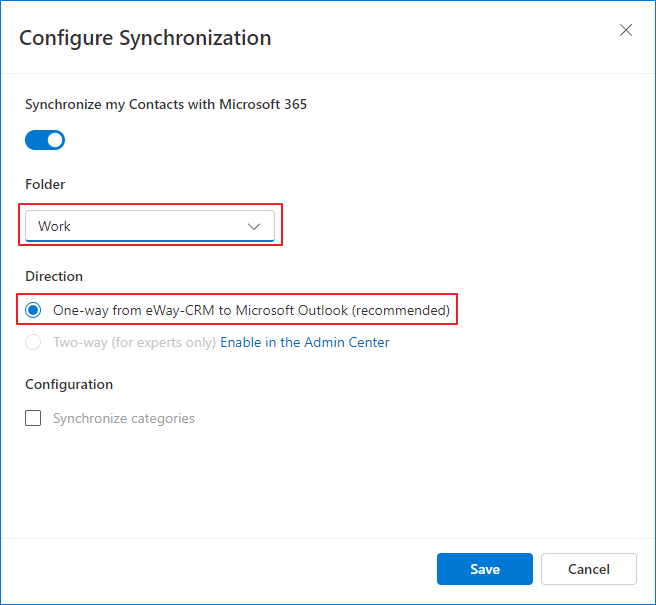
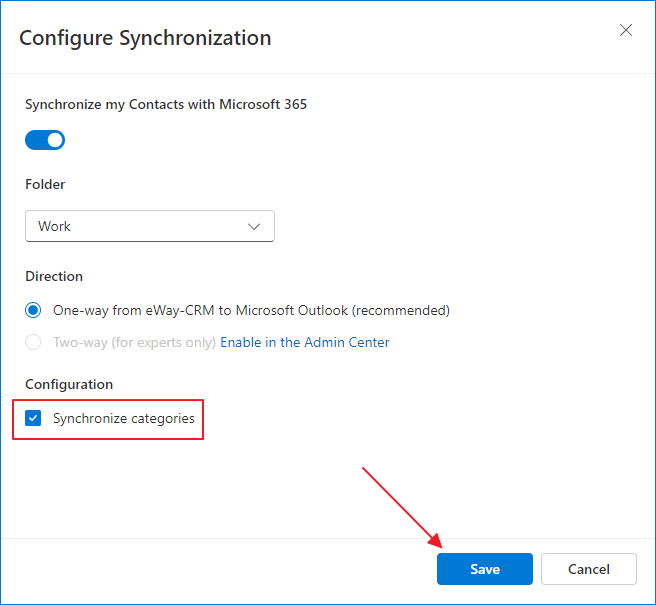
Two-way Automatic Synchronization Between eWay-CRM and Microsoft 365
Warning
Two-way sync automatically removes contacts from eWay-CRM if you delete them from Outlook and vice versa.
Contacts can be deleted from eWay-CRM for another reasons, such as moving them to a different Outlook folder, changing categories, etc.
Be very careful before activating this feature. It can result in damaging or losing your data.
Contacts can be deleted from eWay-CRM for another reasons, such as moving them to a different Outlook folder, changing categories, etc.
Be very careful before activating this feature. It can result in damaging or losing your data.
- On the eWay-CRM ribbon, go to eWay-CRM Settings.
- In Contacts tab, check the box Automatic Synchronization With Microsoft 365 (server mode).
- Then click Configure.
- Turn on the Synchronize my Contacts with Microsoft 365 toggle and login to your Microsoft 365 account.
- Select the folder of Microsoft 365 contacts where you want to synchronize your contacts. The two-way synchronization can be enabled only by administrator who has permissions to access the Administration Center. Administrator must turn on the setting Enable users to activate a two-way sync with Microsoft 365. If the setting is not turned on, the user cannot set up the two-way synchronization.
- If the setting is turned on, select Two-way. Contacts will be synchronized between eWay-CRM and Microsoft 365 in both directions. You can also set whether you want to create companies from contacts synchronized from Microsoft 365 if there is company filled. If you want to create a company, check Automatically create companies. Administrator can forced this option using the setting Create a new company when importing / synchronizing contacts from Outlook, Microsoft 365 or Excel.
- If you want to synchronize also categories of your contacts, check Synchronize categories. Then, click Save.
- The initial synchronization will start. After successful finish, you will see your eWay-CRM contacts in your Microsoft 365 account and the other way around. Every change on contact will be synchronized in the second application.




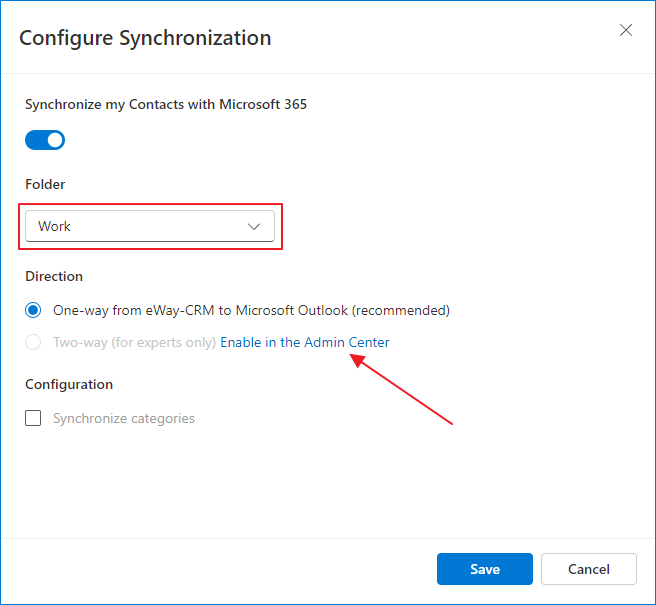
Warning
Two-way sync with automatic creating of companies is tricky. Please be careful. If you sync your eWay-CRM with other databases (ERP, etc.), you can trigger further synchronizations.
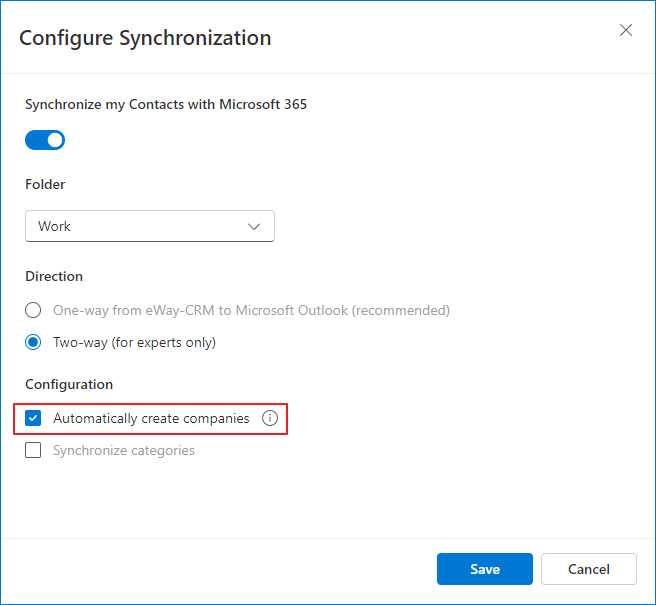
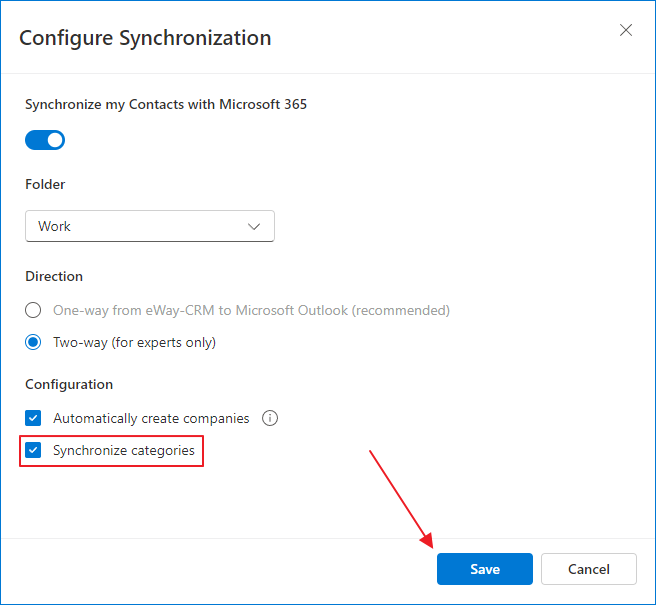
eWay-CRM Online
One-way Automatic Synchronization From eWay-CRM to Microsoft 365
- Klikněte na profilovou fotku v horním pravé rohu vašeho eWay-CRM Online a vyberte možnost Moje nastavení.
- Go to the Contacts tab. Turn on the Synchronize my Contacts with Microsoft 365 toggle and login to your Microsoft 365 account.
- Select the folder of Microsoft 365 contacts where you want to synchronize your contacts from eWay-CRM and click One-way from eWay-CRM to Microsoft 365. Contacts will be synchronized only from eWay-CRM to Microsoft 365, not the other way around.
- If you want to synchronize also categories of your contacts, check Synchronize categories. Then, click Save.
- The initial synchronization will start. After successful finish, you will see your eWay-CRM contacts in your Microsoft 365 account. Every change on eWay-CRM contact will be synchronized to Microsoft 365 too.
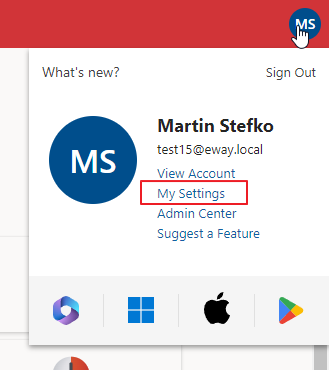
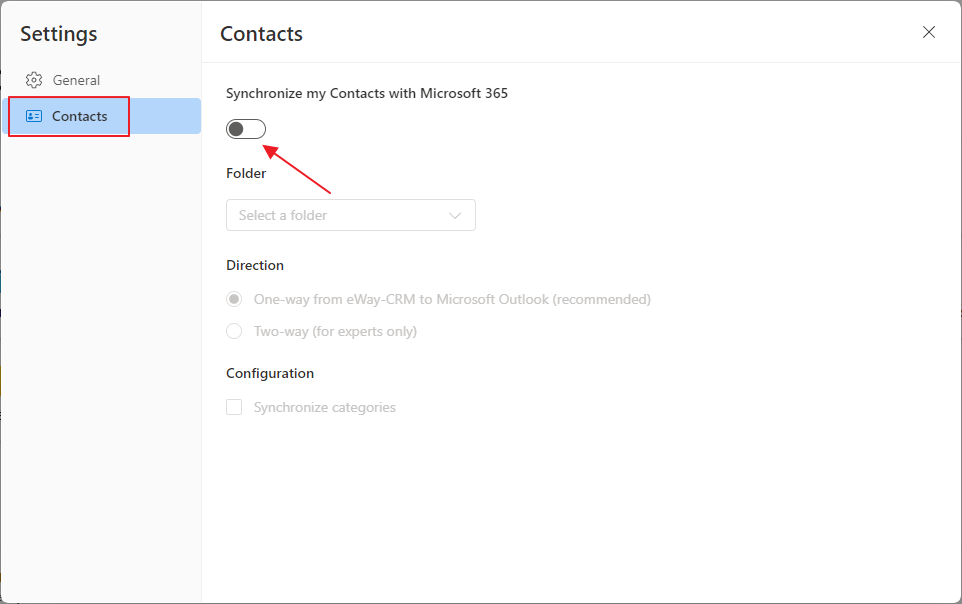
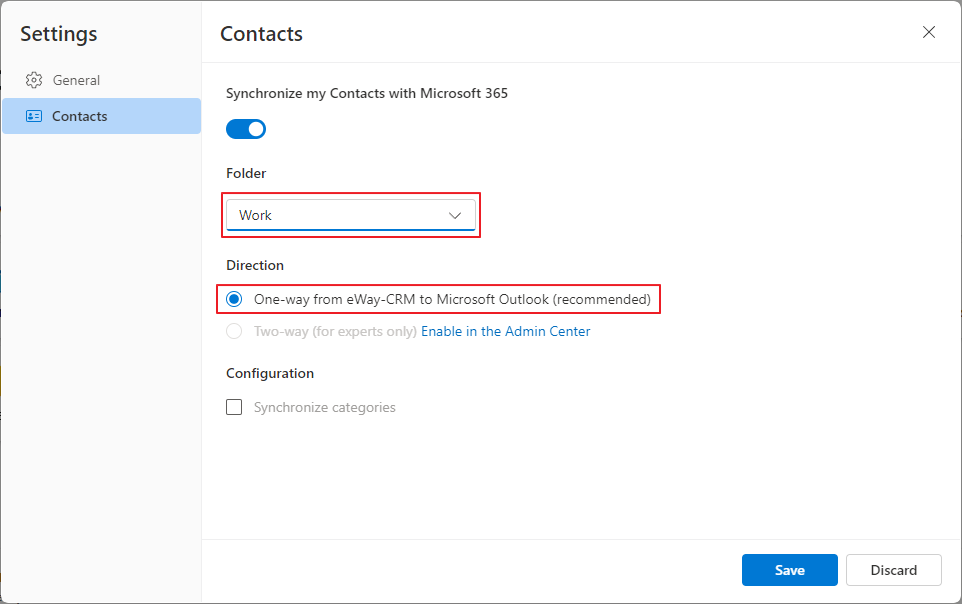
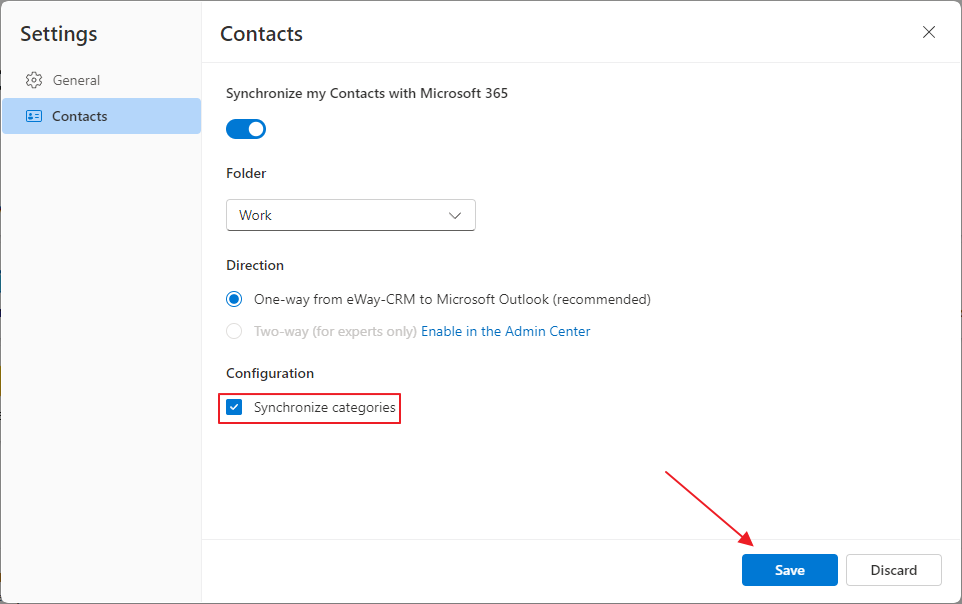
Two-way Automatic Synchronization Between eWay-CRM and Microsoft 365
Warning
Two-way sync automatically removes contacts from eWay-CRM if you delete them from Outlook and vice versa.
Contacts can be deleted from eWay-CRM for another reasons, such as moving them to a different Outlook folder, changing categories, etc.
Be very careful before activating this feature. It can result in damaging or losing your data.
Contacts can be deleted from eWay-CRM for another reasons, such as moving them to a different Outlook folder, changing categories, etc.
Be very careful before activating this feature. It can result in damaging or losing your data.
- Klikněte na profilovou fotku v horním pravé rohu vašeho eWay-CRM Online a vyberte možnost Moje nastavení.
- Go to the Contacts tab. Turn on the Synchronize my Contacts with Microsoft 365 toggle and login to your Microsoft 365 account.
- The two-way synchronization can be enabled only by administrator who has permissions to access the Administration Center. Administrator must turn on the setting Enable users to activate a two-way sync with Microsoft 365. If the setting is not turned on, the user cannot set up the two-way synchronization.
- If the setting is turned on, select Two-way. Contacts will be synchronized between eWay-CRM and Microsoft 365 in both directions.
- You can also set whether you want to create companies from contacts synchronized from Microsoft 365 if there is company filled. If you want to create a company, check Automatically create companies. Administrator can forced this option using the setting Create a new company when importing / synchronizing contacts from Outlook, Microsoft 365 or Excel.
- If you want to synchronize also categories of your contacts, check Synchronize categories. Then, click Save.
- The initial synchronization will start. After successful finish, you will see your eWay-CRM contacts in your Microsoft 365 account and the other way around. Every change on contact will be synchronized in the second application.



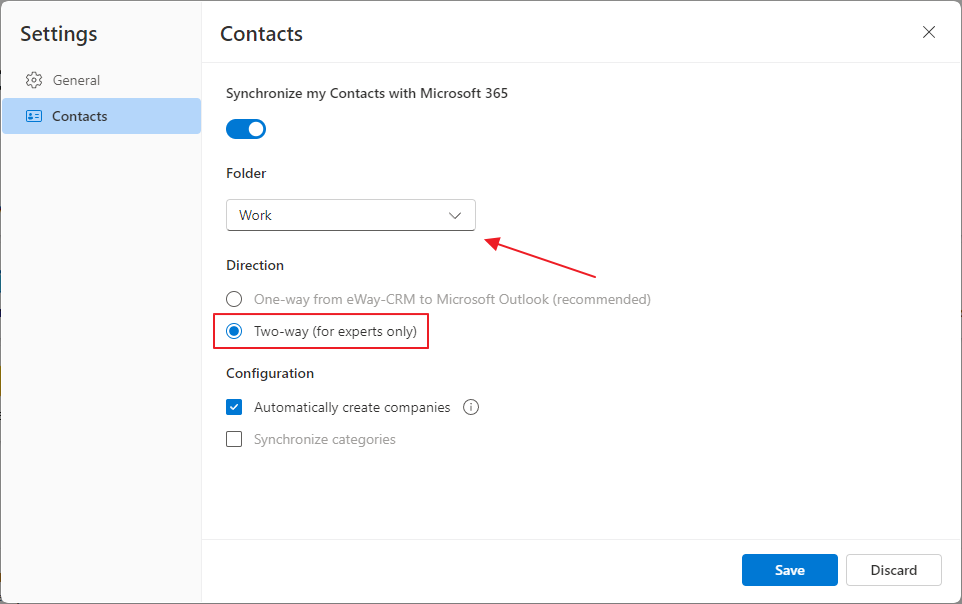
Warning
Two-way sync with automatic creating of companies is tricky. Please be careful. If you sync your eWay-CRM with other databases (ERP, etc.), you can trigger further synchronizations.
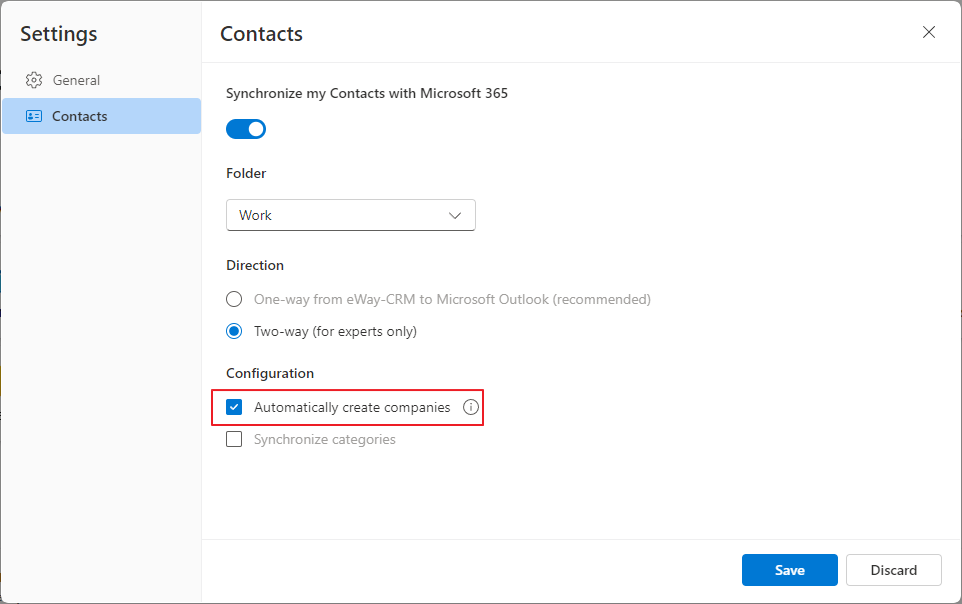
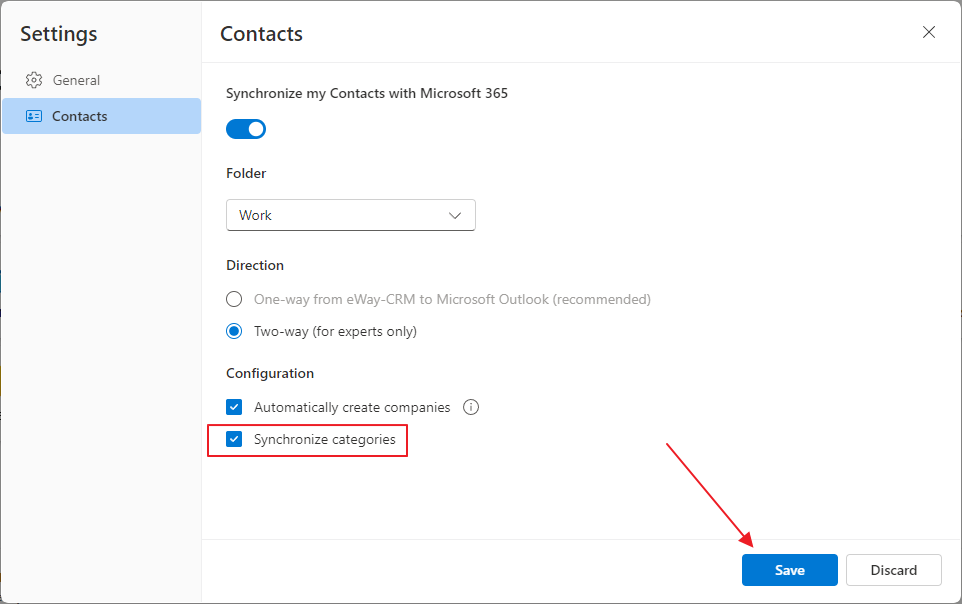
Was it useful?
Continue here
- Synchronize Contacts with Outlook (local)
- Save Emails to Contacts Automatically with Microsoft 365 (server)
- Save Emails to Companies Automatically with Microsoft 365 (server)
- Save Emails to Contacts Automatically with Outlook (local)
- Save Emails to Companies Automatically with Outlook (local)
- Save Emails to Contacts Manually
- Import Contacts From Microsoft 365
- Import Contacts from Microsoft Outlook
- Import Contacts From Emails
- Import Data From Microsoft Excel
- Import Older Emails
- Create Custom Fields
- Create Custom Forms

